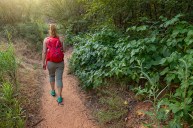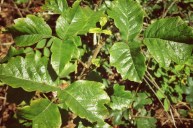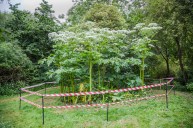Ah the great outdoors. It offers breathtaking views, fresh air, and scenic wildlife. However, another thing that it offers is danger. Not just from the climate and potential dangerous wildlife but from plants. That's right, if you thought leaves and plants couldn't hurt you think again. There are several plants that can pose a threat to human health, whether it is from pesky thorns to harmful toxins. Some of these plants are more common than others and today we want to discuss the ones you are most likely to run into. So here are the 9 most common poisonous plants that you need to be aware of. As well as how to recognize them so you can stay clear.
Common Poisonous Plants And How To Recognize Them
Note that in this article we are focusing on plants that can be found outdoors in the wilderness. This list is not comprehensive but includes a good portion of common poisonous plants that you should be aware of.
Buttercups

Shutterstock Image
Buttercups are a common flower found in fields. According to Texas AgriLife, all parts of this plant are poisonous, and "Irritant juices may severely injure the digestive system." While a common childhood game is holding this flower under your chin and seeing if your chin turns yellow, be sure not to allow the plant to come in contact with your skin. That is because all buttercups contain a compound called ranunculin. If you crush or bruise the leaves of this plant it breaks that compound down into a toxic oil that can cause irritation to your skin, including rashes and blisters. If leaves are chewed or ingested blisters can form in the lips and mouth and digestion irritation will ensue. Followed by dizziness, spasms, and maybe even paralysis.
How To Recognize:
Buttercup flowers are typically yellow with 5 petals. Although sometimes they can be white. They typically flower in the spring. Additionally, they are found worldwide but favor moist woods, meadows, open fields or wetlands. However, they can be found on roadsides as well.
Cow Parsnip

Shutterstock Image
Cow parsnip is found across North America and can have some truly irritating effects. Contact with this plant can cause skin irritation, blistering rashes, and skin discoloration. This plant can affect you if its sap comes in contact with your skin and then is exposed to sunlight.
How To Recognize:
This plant is quite large and has lobed leaves divided into three leaflets — like a maple leaf. It has a tall, hollow stem that can have some purple spots. The flower head is large with a cluster of tiny white flowers that form an umbrella shape. Additionally, this plant reaches several feet tall and prefers moist areas.
Giant Hogweed

Shutterstock Image
Although native to Asia, this plant has become an invasive species in the U.S. Appearing similar to the Cow Parsnip, this plant reaches impressive heights and has thick, hollow stems with purple spots. If you come in contact with it you can get blistering rashes. Contact with eyes can lead to blindness.
How To Recognize:
This plant looks similar to the Cow Parsnip in that it is tall, with hollow stems and purple splotches. However, this plant has clear pronounced purple splotches and its leaves are large. It also has white flowers in an umbrella shape.
Moonseed

Shutterstock Image
This plant is especially dangerous because it resembles a delicious, edible fruit. Do not be fooled by its grape-like appearance, all parts of this plant are deadly. While this is a common poisonous plant, many people do not know about it or how to recognize it. Simply touching the plant may not elicit a reaction, but ingesting it will. If you ingest this plant you can experience nausea, vomiting, and severe stomach pain. The results can be fatal.
How To Recognize:
Moonseed berries appear blue-purple in color, resembling wild grapes. However remember, moonseeds have a crescent shape while grapes are more round. Additionally, this plant will have a climbing vine, with leaves that have a minute, sharp point.
Nightshade

Shutterstock
Nightshade is another plant in which all parts are poisonous. While many people have heard of this common poisonous plant, few know how to recognize it. Similar to the moonseed plant, Nightshade looks like it has delicious, edible berries. DO NOT CONSUME them. The berries are highly poisonous, as well as the leaves. The U.S. Forest Service shares the following symptoms with ingesting the berries of this plant. "Abdominal pain, thirst, restlessness, flushing, and skin irritation." Or in more severe cases, "vomiting, difficulty breathing, dilated pupils, diarrhea, bloody urine, loss of sensation, and even death."
How To Recognize:
This plant has bell-shaped, brown—purple flowers, oval-shaped leaves, and large, shiny black berries.
Poison Hemlock

Shutterstock Images
Similar to other common poisonous plants, Poison Hemlock is an invasive species that is not native to North America. Nevertheless, all parts of this plant are highly poisonous to people and animals. Even ingesting a tiny amount of this plant is enough to potentially kill you.
How To Recognize:
Similar to other poisonous plants on this list, this plant has a hollowed stem with purple or red spots on it. Additionally, it has triangular dark green, fern-like leaves. Its flowers also resemble the small, white umbrella shape. At this point if the stem has purple spots and the flowers are tiny white clusters in an umbrella shape...STAY AWAY!
Poison Ivy

Shutterstock Image
This is probably one of the most common and well-known poisonous plants there is. Everyone has heard of poison ivy. You can contract symptoms by directly touching the plant or by touching something that has come in contact with the plant's oils such as clothing, someone else, or a pet. Symptoms include itchy, red swollen skin with painful blisters.
How To Recognize:
The Children's Hospital of Philadelphia shares the following about how to recognize poison ivy. It "usually has three broad, tear-shaped leaves. It can grow as a climbing or low-spreading vine that sprawls through grass." They continue, "It is found everywhere in the United States except Alaska and Hawaii. It often grows along rivers, lakefronts ,and ocean beaches."
Poison Oak

Shutterstock Image
Poison oak is similar to poison ivy in the reactions that it creates. The severity of the reaction is dependent upon how allergic the person who came in contact with the plant is. This plant carries the same poison as the poison ivy plant and often elicits the same reaction.
How To Recognize:
This plant's leaves look like oak leaves that grow as a vine or a shrub. The plant can have three or more leaflets per group.
Poison Sumac

Shutterstock Image
That saying "leaves of three, leave them be" seems to be holding true. This plant also has the same poison that poison ivy and poison oak have. Similarly, it creates the same reactions when touched.
How To Recognize:
This common poisonous plant has seven to 13 leaflets per stem that are characterized by smooth surfaces and pointed tips. It is most often found in wooded, moist areas of the southern United States.




